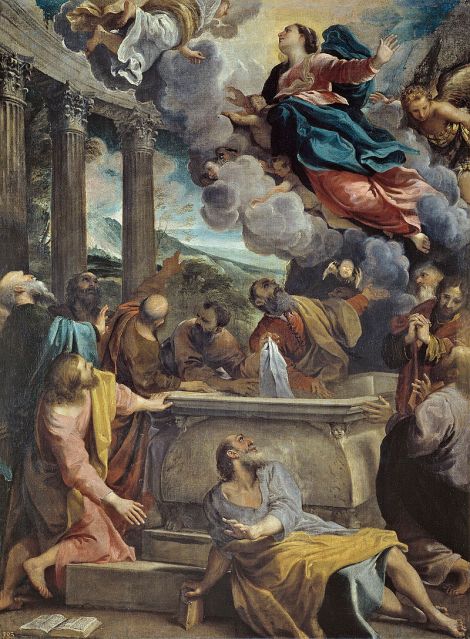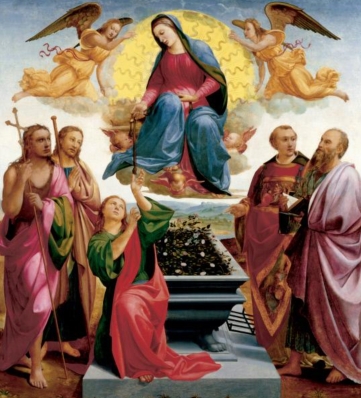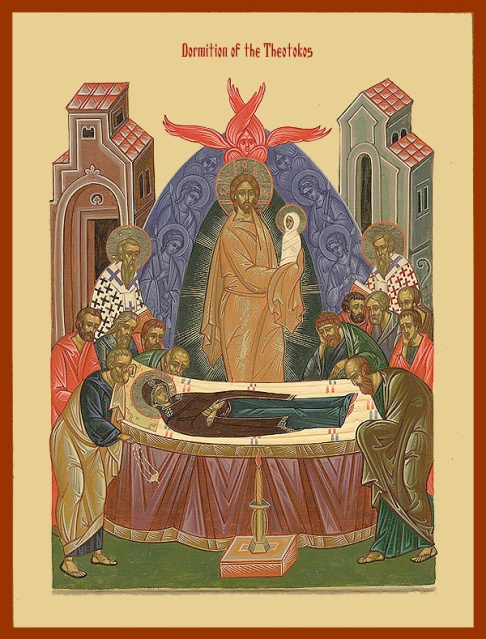Did Our Lady die? Until recently, I would have said no; she was assumed into heaven because of her purity. I must admit I had not investigated the idea thoroughly, but for a long time I was under the impression that this meant that she underwent a transition from earth to heaven that was like a sort of Marian Ascension, not quite alive, but not quite dead either.
This impression was reinforced by paintings such as the one below in which she is elevated by angels while, it appears, very much alive. And, furthermore, this special transition through a stage of the holy undead even has a special name in the Eastern Church, which refers to her ‘Dormition’ – a kind of falling asleep. Or so I thought.
To my knowledge there is nothing wrong theologically with the painting above, which is by the great Italian baroque artist Guido Reni. But, it doesn’t tell the full story. Have a look at this painting of the Assumption by the 17th century Italian, Annabale Carraci :
At the top we have the familiar scene of Our Lady being drawn up to heaven by angels, but at the bottom we see in addition a group of onlookers who surround a tomb. This scene begs the question, if Our Lady didn’t die, why have a tomb? We see the same in the painting below by the 18th century Italian, Piazetta. In this not only do we see the tomb, but also there is great shock, revealed by a dramatic gesture, at the fact that the tomb is empty.
Clearly, the reason for this is that Our Lady did die at the end of her earthly life (or at least these artists believed so). In fact this always been the tradition of the Church, East and West. The tradition can be traced back as far as the 4th century which is the time attributed to the writing of a document called The Account of St John the Theologian of the Dormition of the Mother of God. The word Dormition means literally, falling asleep, but is used to mean a peaceful death. The tradition says that three days after her death she was not in her sarcophagus, instead it was full of fragrant flowers. We see these in the image below painted by Francesco Granacci painted in 1515.
Below we see two iconographic representations in which the death is more apparent. There is a separation of body and soul, which is received by Christ himself, even before the Assumption. It is represented by the white clad figure he is holding.
Above: a mosaic in Santa Maria Maggiore, Rome XIII century;
and below: a modern icon of the Eastern Church.
So it seems I was wrong in thinking that she didn’t die? Well…probably. While tradition says that Our Lady did die; the dogmatic statement of Pius XII is ambiguous. In Munificentissimus Deus, published in 1950, he states that her body was incorrupt and was assumed into heaven, but doesn’t go so far as to say that she dies first. So one might argue, I am not bound to believe that she died.
I am happy to go with tradition and accept that she did die however, and am greatly encouraged by this thought. For what Our Lady experienced is bodily resurrection, a participation in the bodily resurrection of Christ, which is offered to all of us. For most of us, unlike Our Lady, there will be bodily corruption beforehand, but ultimately, we have the chance of going to heaven too.







Either belief is acceptable. The doctrine is that Mary was assumed bodily into Heaven. It does not stipulate whether or not she died first. So the faithful are free to believe either way.
LikeLiked by 1 person
That is my understanding too, but I think that the idea that she didn’t die is more recent – something not seen in the writings of the Church Fathers? Even then I wouldn’t argue that this makes it wrong, but rather that it is a newer development in the theology, that might be true. Does this sound right to you Deacon?
LikeLike
Sure, it is interesting to speculate on why this is a recent development. I wonder if it might be due to the renewal of iconography and more exposure to the eastern idea of the dormition, or “falling asleep” of Mary. But we should also remember that even scripture uses “falling asleep” to refer to the faithful who have died.
LikeLike
Yes – to my understanding in the Eastern Church ‘Dormition’ refers to a peaceful death.
LikeLike
If you don’t believe she died your in danger of Elivating her above Jesus and this would fully separate your Protestant brothers and sisters. We don’t want to do such a thing we are all one in Christ we must live it.
LikeLike